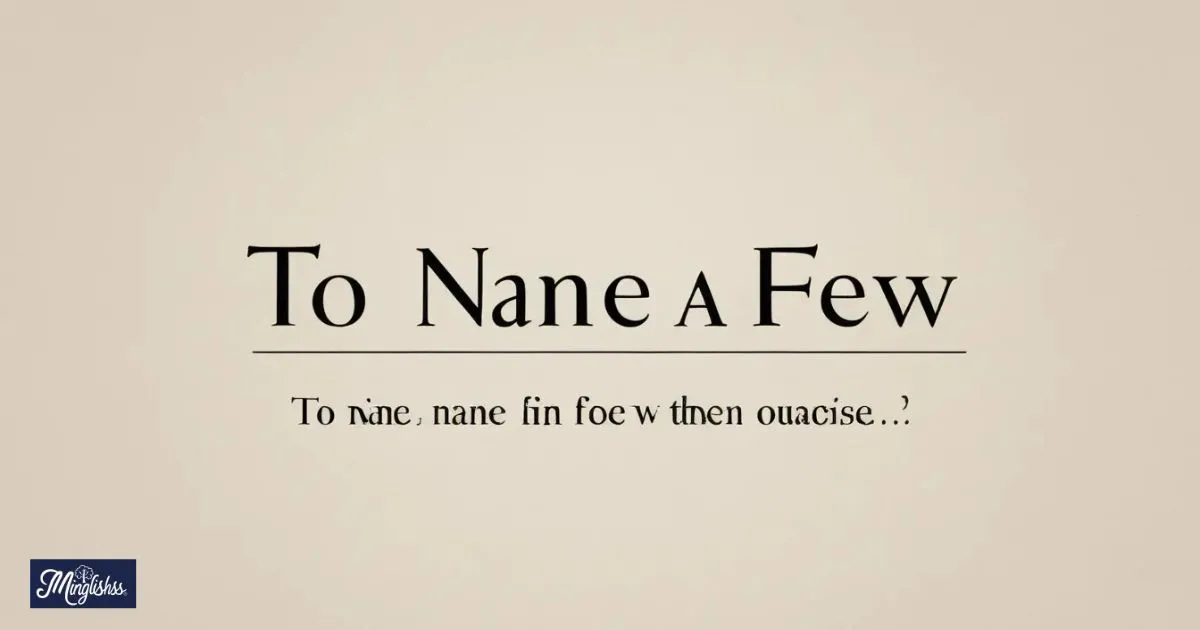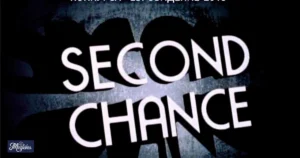“Exploring new ways to express yourself can make your language more engaging and precise.”
When we want to highlight a few examples or provide specific instances without listing everything, we often use the phrase “to name a few.” This phrase is effective, but overusing it can make our language repetitive. Expanding your vocabulary with alternative expressions can add color, depth, and sophistication to your writing or conversations.
Using a variety of expressions can also help you tailor your message to different situations, whether formal, casual, or creative. By switching things up, you keep your audience interested and avoid sounding monotonous. This guide introduces you to 35 unique ways to convey “to name a few,” with tips on when and how to use each one.
Each phrase here is presented with a scenario and detailed explanation, followed by an additional tip on how best to incorporate it into your speech or writing. With these options, you’ll have a well-rounded toolkit for any context where listing a few examples is key.
35 Alternatives to “To Name a Few”
1. “For Instance”
Scenario: When giving an example of effective communication skills in a presentation, you might say, “Public speaking, storytelling, and active listening, for instance, are vital.”
Explanation: This phrase is widely used in both written and spoken language to offer one or a few examples, making it clear that the list isn’t exhaustive.
Additional Tip: Use “for instance” in formal and casual situations. It’s simple and direct, making it great for any audience.
2. “Such As”
Scenario: In a classroom setting, you might say, “There are several genres of literature, such as mystery, romance, and science fiction.”
Explanation: This phrase is effective for introducing one or more examples that fall within a category you’re discussing.
Additional Tip: “Such as” flows smoothly in sentences and works well in written English. Use it when you want to sound informative without going overboard.
3. “Like”
Scenario: During a work meeting, Sarah mentions, “We could consider a few marketing strategies, like email campaigns, social media ads, and influencer partnerships.”
Explanation: This simple phrase is often used in everyday language and can make your sentence sound more conversational.
Additional Tip: “Like” is informal, so it’s best in casual settings or creative writing. It’s ideal for making examples sound approachable.
4. “To Illustrate”
Scenario: Mark, a teacher, explains, “There are various problem-solving methods, to illustrate, brainstorming and root-cause analysis are useful.”
Explanation: This phrase is slightly more formal, making it a good choice for academic or professional settings.
Additional Tip: Use “to illustrate” when you want to clarify or elaborate on a point, especially when discussing complex subjects.
5. “As an Example”
Scenario: While mentoring, Chloe suggests, “A few types of motivation work well with students; as an example, praise and constructive feedback.”
Explanation: This phrase is commonly used to emphasize a single, specific example in a sentence.
Additional Tip: Use this in more detailed explanations to make your point clearer. It’s a gentle, straightforward choice.
6. “Namely”
Scenario: In a business report, James writes, “We aim to improve customer service in three areas, namely, responsiveness, personalization, and consistency.”
Explanation: “Namely” is a slightly formal phrase often used to introduce a specific list of examples.
Additional Tip: Use this in professional or formal writing to sound precise and authoritative. It’s great for itemized points.
7. “For Example”
Scenario: During a workshop, Maria explains, “There are several healthy habits to adopt, for example, regular exercise, balanced nutrition, and enough sleep.”
Explanation: One of the most commonly used phrases to provide examples, this phrase works across most contexts.
Additional Tip: “For example” fits in both formal and informal settings, making it versatile for presentations and everyday conversations alike.
8. “As Seen In”
Scenario: In a marketing class, Daniel states, “Many brands use color psychology, as seen in brands like McDonald’s and Coca-Cola.”
Explanation: This phrase points to examples people may recognize, helping make your point more relatable.
Additional Tip: “As seen in” is excellent for situations where familiarity with examples aids understanding, such as advertising.
9. “Including but Not Limited To”
Scenario: In a workshop, Lily says, “There are multiple platforms for online learning, including but not limited to, Coursera, Udemy, and Skillshare.”
Explanation: This formal phrase is ideal for introducing a list without restricting it to the mentioned items.
Additional Tip: Use this phrase in legal, technical, or formal documents to imply flexibility without sounding vague.
10. “In Particular”
Scenario: During a lecture, George mentions, “Some subjects, in particular, physics and chemistry, require analytical thinking.”

Explanation: This phrase is used to emphasize specific items within a broader category.
Additional Tip: “In particular” is best used when you want to highlight examples that are especially relevant.
11. “As Demonstrated By”
Scenario: At a workshop, Emma explains, “Different methods can improve productivity, as demonstrated by time-blocking and the Pomodoro Technique.”
Explanation: This phrase is helpful for showing evidence through examples and works well in professional or educational contexts.
Additional Tip: Use “as demonstrated by” when you want to support an idea with known examples, especially when explaining methods.
12. “A Prime Example Being”
Scenario: When discussing environmental efforts, David says, “Companies are reducing waste; a prime example being IKEA’s sustainable packaging.”
Explanation: This phrase is excellent for introducing a strong, clear example that stands out.
Additional Tip: Use “a prime example being” in persuasive writing or presentations where you want to highlight standout cases.
13. “Chiefly”
Scenario: During a finance presentation, Lisa points out, “There are several ways to save money, chiefly budgeting and reducing unnecessary expenses.”
Explanation: This word is suitable for presenting a main example or focus within a broader idea.
Additional Tip: Use “chiefly” when you want to sound succinct and to the point, especially in professional settings.
14. “Among Them”
Scenario: In a casual discussion, Carl says, “There are many ways to stay healthy, among them, regular exercise and balanced eating.”
Explanation: This phrase gives a smooth, natural way to add examples without listing all possibilities.
Additional Tip: “Among them” is flexible and can fit in both formal and informal contexts, making it a good general-purpose option.
Other Ways to Say “Unless Otherwise Specified”
15. “Notably”
Scenario: While discussing technological advancements, Anna mentions, “Social media has evolved greatly, notably through platforms like Instagram and Twitter.”
Explanation: This phrase is used to draw attention to particular examples, usually in contexts of innovation or progress.
Additional Tip: Use “notably” to sound impactful, especially in speeches or presentations about significant developments.
16. “As Evidenced By”
Scenario: During a medical lecture, Dr. Smith says, “Preventative health is effective, as evidenced by vaccinations and regular check-ups.”
Explanation: This phrase is often used to show proof through specific examples.
Additional Tip: “As evidenced by” works well in scientific or factual presentations, where examples serve as support for your claim.
17. “A Few of Which Are”
Scenario: In a project update, Mike explains, “We’ve explored different user engagement strategies, a few of which are targeted emails and loyalty rewards.”
Explanation: This phrase is a great way to give a limited number of examples from a broader list.
Additional Tip: Use “a few of which are” to indicate variety without sounding exhaustive. This is ideal for reports or updates.
18. “Some Instances Are”
Scenario: During a presentation on innovation, Mark says, “Creativity can manifest in various ways; some instances are brainstorming and rapid prototyping.”
Explanation: This expression introduces examples that clarify what you mean without an exhaustive list.
Additional Tip: Use “some instances are” to give a few concrete examples, especially in business or creative discussions.
19. “By Way of Example”
Scenario: In a leadership training, Olivia shares, “There are different approaches to team motivation, by way of example, positive reinforcement and goal-setting.”
Explanation: This phrase introduces examples elegantly and fits well in formal settings.
Additional Tip: “By way of example” works best in professional writing or public speaking when you want to sound polished.

20. “A Sample of This Includes”
Scenario: During a project briefing, Claire says, “We’re looking into various data sources; a sample of this includes survey data and customer feedback.”
Explanation: This phrase gives a sense of variety within a limited scope.
Additional Tip: Use this in reports or updates to give readers a quick sense of what’s included in a larger dataset or study.
21. “An Array of Which Are”
Scenario: In a technology meeting, John explains, “There are multiple ways to enhance user experience; an array of which are personalized content and intuitive design.”
Explanation: This phrase emphasizes a broad selection without detailing each item.
Additional Tip: “An array of which are” is ideal for broad lists in both formal and semi-formal settings.
22. “Illustrated By”
Scenario: In a design workshop, Samantha mentions, “Effective layout principles are essential, illustrated by alignment and contrast.”
Explanation: This phrase is great for introducing examples that visually represent the idea being discussed.
Additional Tip: “Illustrated by” is perfect for visual concepts and makes your point easier to grasp.
23. “An Example Being”
Scenario: In a class, Professor Lewis says, “There are many psychological principles to consider, an example being cognitive dissonance.”
Explanation: This phrase singles out one example, making it effective for a quick, specific mention.
Additional Tip: Use “an example being” when you want to highlight a single, clear instance within a broader topic.
24. “Representative Examples Include”
Scenario: In a scientific report, Dr. Kim writes, “Various ecosystems support unique species, representative examples include rainforests and coral reefs.”
Explanation: This phrase is useful in formal contexts where you’re listing examples that represent a larger group.
Additional Tip: Use “representative examples include” in detailed explanations where you want to provide precise information.
25. “Take for Example”
Scenario: During a debate, Mia argues, “Several countries have universal healthcare, take for example, Canada and Sweden.”
Explanation: This phrase smoothly introduces examples in an informal or conversational way.
Additional Tip: Use “take for example” in both formal and informal situations to emphasize one or two relevant cases.
26. “An Illustration of This Is”
Scenario: In a history lecture, Professor Anderson says, “Many revolutions were impactful, an illustration of this is the French Revolution.”
Explanation: This phrase works well to emphasize a historical or factual example that supports a statement.
Additional Tip: Use “an illustration of this is” in academic or descriptive writing to present evidence for a point.
27. “Chief Examples Include”
Scenario: While discussing art styles, Jess states, “There are diverse art movements, chief examples include Impressionism and Cubism.”
Explanation: This phrase points to the main or most significant examples in a group.
Additional Tip: “Chief examples include” is best in formal settings when you want to highlight key items.
28. “With Examples Like”
Scenario: In a cooking show, Chef Maria says, “Different cuisines use unique spices, with examples like turmeric in Indian food and basil in Italian dishes.”
Explanation: This phrase is conversational and versatile, fitting both casual and formal uses.
Additional Tip: Use “with examples like” to give an inviting tone to your list, especially when talking about a familiar topic.
29. “As Seen With”
Scenario: In a business meeting, Raj says, “There are many successful tech companies, as seen with Google and Apple.”
Explanation: This phrase introduces well-known examples, adding credibility to the point.
Additional Tip: Use “as seen with” to reinforce your message by mentioning familiar or prominent examples.
30. “Such Noteworthy Examples Include”
Scenario: In an environmental talk, Ella states, “Some animals are vital to ecosystems, such noteworthy examples include bees and sea otters.”
Explanation: This phrase is formal and highlights particularly significant examples.
Additional Tip: Use “such noteworthy examples include” in educational or formal contexts to add emphasis to your points.
31. “Demonstrative Examples Include”
Scenario: In a tech seminar, Sarah says, “Many programming languages are versatile, demonstrative examples include Python and JavaScript.”
Explanation: This phrase adds a formal tone, suitable for academic or professional settings.
Additional Tip: Use “demonstrative examples include” when you want to sound precise and scholarly.
32. “Exemplified By”
Scenario: During a social sciences class, Professor White explains, “Effective communication methods are vital, exemplified by active listening and feedback.”
Explanation: This phrase introduces a strong example in a more formal tone.
Additional Tip: “Exemplified by” is ideal for professional or academic presentations, where examples support a theory or concept.
33. “For Purposes of Example”
Scenario: At a workshop, Tom says, “Various digital tools can improve productivity; for purposes of example, we use Trello and Slack.”
Explanation: This phrase fits well in formal documents or presentations, setting up an example purposefully.
Additional Tip: Use “for purposes of example” when you want to be particularly clear about why you’re providing an example.
34. “As Illustrated By”
Scenario: In a business article, Anne writes, “Innovation often stems from collaboration, as illustrated by companies like Google and Pixar.”
Explanation: This phrase is excellent for showing how specific examples back up a statement.
Additional Tip: Use “as illustrated by” in professional or educational writing, where examples clarify concepts.
35. “Consider the Example of”
Scenario: During a conference, Leo mentions, “Leadership can take many forms; consider the example of servant leadership practiced by some CEOs.”
Explanation: This phrase is an engaging way to introduce a single, illustrative example for consideration.
Additional Tip: Use “consider the example of” to create an interactive tone, inviting your audience to think about the example provided.
Pros and Cons of Using Alternative Expressions
Pros
- Enhances Communication: Diverse expressions can make language more interesting and clarify meaning.
- Flexibility: You can match phrases to different audiences and tones, from formal to informal.
- Prevents Repetition: Using various phrases avoids overusing “to name a few” and keeps communication fresh.
Cons
- Potential Confusion: Less common phrases might require explanation, especially with unfamiliar audiences.
- Inconsistency: Using too many different expressions in a single conversation or document can make it feel disjointed.
Conclusion
Having multiple ways to say “to name a few” broadens your communication style and ensures your message stays engaging. By using these 35 expressions, you can cater to various audiences and contexts.
Whether you’re speaking casually or writing formally, these alternatives add richness to your language and keep your listeners or readers interested. Try experimenting with these options to find what resonates most with your style, and watch your communication become more effective and engaging.
Answers to Key Question “To Name a Few”
1. Why should I use alternatives to “to name a few”?
Using alternatives makes your language more dynamic and prevents redundancy, especially in long conversations or texts.
2. Can I use these phrases interchangeably?
Yes, many can be used interchangeably, but some fit better in specific contexts, like formal or casual settings.
3. Are these alternatives suitable for professional writing?
Absolutely. Most of these options, like “for instance” or “namely,” work well in formal and professional documents.
4. How do I know which phrase to choose?
Consider your audience and tone. Use simpler phrases in casual settings and more formal ones in professional contexts.
5. Is there a risk of sounding repetitive if I use these phrases?
Not if you use them sparingly and appropriately. Rotating through different expressions can keep your writing fresh.

Hi, I’m Isabel: I’m passionate about turning language learning into a fun adventure. I believe in making every word exciting and memorable.










